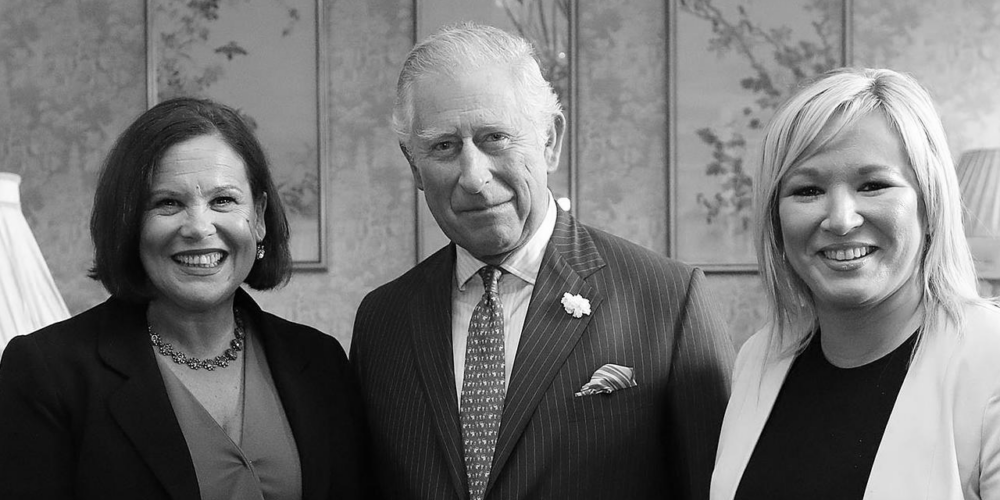Sinn Féin, in a historical victory in the northern assembly, becoming the largest party with 27 seats compared with the DUP’s 25 seats, has crossed a threshold that looks likely to be repeated in the South in the near future. Countless articles have been written on the metrics and projections, so there will be no further discussion of these in this article. What will be attempted here is to frame the ascendency of Sinn Féin under the lens of the “Cartel Party model”, to offer an analysis that objectively looks at the limits of what alternative Sinn Féin can offer. This isn’t to target Sinn Féin specifically, but to try to demonstrate that under the present conditions and balance of class forces, any opposition party in the Dáil will sooner or later be adopted into the political party cartel in its ascent to political governance.
The Cartel Party model was first developed in 1992 by Richard Katz and Patrick Mair[1], who looked at the shifting dynamics and make-up of political parties, from mass parties to catch-all-parties to what may now best be described as cartel parties – an oligopoply/monopoly market of political parties in which rather than competing on policy, competition rests on their ability to politically manage the economic system: the capitalist economy. This author has previously added to the theory on the basis of a class analysis of the cartel model. For Sinn Féin, in general terms, their upswing of support can be broken into two general areas: a growth in support of a United Ireland, partly flowing from Brexit, and a growth in support for an alternative to the establishment political parties.
When previously addressing the subject in 2014-2015, Sinn Féin could have been regarded as being outside the cartel model: a party whose principles went against the establishment status quo regarding austerity, the EU, NATO, militarisation, neutrality, unification, support for anti-imperialist struggles, i.e. Cuba, Palestine, etc. In order to establish whether Sinn Féin have succumbed to the cartel party model or if it still holds its credentials of being an alternative to the establishment, to the cartel, we will look at four different categories and apply them to current SF policies and statements.
Four criteria of the cartel model:
1) Decreased dependence on grass-roots funding, more in favour of funds raised by central government.
2) Organisational changes designed to free central party leaders from control by active elements of the party on the ground.
3) Policy convergence among parties – (i) downsize expectations (ii) free parties from traditional policy responsibilities and constituencies – increasing institutional externalisation of such commitments.
4) An “ideology” of managerial competence to replace the various ideologies of principle as basis for choice among parties
Before delving any further, let’s expand a bit on the cartel model and why parties who grow in popularity are vulnerable to joining it. In the 21st century, we have witnessed a shift in the make-up of political parties from being popular mass parties, where party life was intertwined with personal life. However, right across the Western world, within our representative democracies, political parties became much more savvy, relying much less on mass support but shifting towards professionalistion, in other words professional politicians trained for a career in political life and the hiring of other professionals in media or drafting policy, to get their message across. This in effect de-coupled political parties from mass-support and so, right across Europe, the membership of political parties shrank.
In order then to maintain a career in politics, one had to be continually re-elected or be appointed to positions by elected colleagues. The result of this is parties that were all about trying to manage and stablilise the economy. Given that the Irish economy from the 80s onwards was an economy built around a comprador bourgeoisie – a coalition of gombeen-men who profited from construction, property speculation and the financing of the deals on behalf of foreign capital – and finance capital, government policy has been geared toward protecting and expanding their interests. This is why we have observed policy convergence among parties: i) downsizing of expectations, and ii) freeing parties from traditional policy responsibilities and constituencies, increasing institutional externalisation of such commitments and support for EU/euro membership and treaties, etc.
In effect, within the cartel parties, actual government policy narrows in scope and with a lack of policy differentiation, the risk of failure (the party being wiped out) is much less likely, bar in extreme circumstances of economic crisis. Therefore, as a career politician, your interests are much more secure. This in turn means that both in government and opposition, such parties will always have a chance to govern, as long as they can “stay in the race”. Once you are inside the cartel your “brand” of politics is centred around how well you can manage the interests of the economic model rather than bringing about an alternative, or sweeping changes to policy that go against or are antagonistic to those interests.
So with Sinn Féin professing themselves to be an alternative to Fianna Fáil/Fine Gael, which is manifesting in an upswing in their popularity, the question we ask is whether or not they will be able to withstand the power of the cartel, the closer they get to government power. In terms of policy alternatives, SF have released a large number of policy documents (59 since 2019), ranging from the cost of living crisis, a vision for renewable energy, delivering affordable homes, childcare, healthcare, public transport, gambling and a whole host of other areas with greater or lesser importance for communities in Ireland north and south. This by any measure is an impressive feat and by all accounts their policy-makers have been busy on the ground listening to the challenges that people face on a day to day basis.
From reading and sifting through a lot of these documents, it is difficult to see significant or meaningful alternatives on offer. This is meant by way of observation rather than criticism as the goal here is to analyse where SF lie: within or outside the cartel. Absolutely, they are offering different solutions to the many crises people face than the governing parties, which is welcome; however their fundamental economic strategy does not challenge the power of the gombeen and finance capitalists. The economic base can remain intact even if the political superstructure changes for the first time in generations.
Given this and the fact that they have or are making signals to reverse their previous principled positions regarding the EU, NATO and, by extension, neutrality, these signals demonstrate to US and EU investment and finance capitalists that principles will not get in the way of pragmatism for SF. As Mary Lou McDonald contends in a recent question posed to her about the Party’s alignment in the pan-European political grouping: “For us, it’s a question of positioning ourselves in the best possible way to advance positive politics, progressive politics, and also Irish interests”.[2] What this alludes to is that criteria 3 and 4 have been satisfied in the affirmation of the cartel.
Under criteria 1, a decrease dependence on grass-roots funding, more in favour of funds raised by central government: evidently the more TDs one has, the more funding will be sourced from central government. However, looking at SIPO figures[3] which are summaries of two main sources of income, it is interesting to note the drop in membership and subs between 2020 and 2021 (from €195,000 to €128,000; with state funding increasing from €4.7m to €5.1m in the same period). Any party that has a certain number of elected officials will be more dependent on central government funds, hence more jobs at risk if the party doesn’t insulate itself within the cartel. Taken on its own, it won’t tell us if the party has been adopted into the cartel model, but taken with criteria 3 and 4, a more compelling case can be argued.
In terms of criteria 2, organisational changes designed to free central party leaders from control by active elements of the party on the ground: this is much harder to qualify as inner-party democracy and organisation is not going to be publicly broadcast. It is hard for this author to state whether statements made by party leaders or spokespersons have been agreed upon by SF internal debate and agreements, only SF members and those close to SF can answer this. So there is no way to prescribe criteria 2 with any certainty.
In summary there seems to be a shift in the direction of SF to come under the banner of the cartel party model in Ireland. We can say that 3 of the 4 of the criteria have been satisfied, but more importantly their vision of an alternative is to reform current government policy through budgetary measures rather than attempting to transform the economic base. So whether it is today, tomorrow or some day in the future, SF, without a principled ideological alternative to the power of the ruling class and its economic base, driven by its grass roots membership, will succumb to the cartel party and join FF/FG/Lab/Greens.
The reality is that political parties in our parliamentary democracies now constitute a profession of managing the affairs of business. If business drops or pulls out of the country, the economy slumps, reflected in higher unemployment, budget cuts, tax increases and ultimately the removal of that party from power, as we have seen time and time again. That is why parties prescribed as alternatives in parliamentary democracies find it nearly impossible to stay principled on their ideology and pre-election policies. To do so would lead to their demise. In government aspiration and promises quickly get consumed by the pragmatism of conscribing to the diktats of the capitalist ruling class.
All those on the left and those seeking an alternative will put their votes and hopes towards SF and other left party/independent candidates in the coming elections, to make positive and progressive reforms to the current system, to tackle the cost of living, healthcare, housing, ecological and the myriad of other crisis plaguing our people. However, our expectations should not exceed their ability to deliver the reforms they lay out in their policy documents. Only a class-orientated party made up of the working class and her allies, looking to take power off the ruling class, to change the economic base, can offer a viable long-term substitute and solution to the current crisis, and at this stage no political party in Ireland is large and strong enough to challenge for power.
[1] Katz, RS and Mair, P. (2018) Democracy and the Cartelization of Political Parties, Oxford University Press.
[2] “Will Sinn Féin ditch its comrades in Europe on its path to power?” (25th May 2023) The Irish Times
[3]Sinn Féin Statement of Accounts. (sipo.ie)






